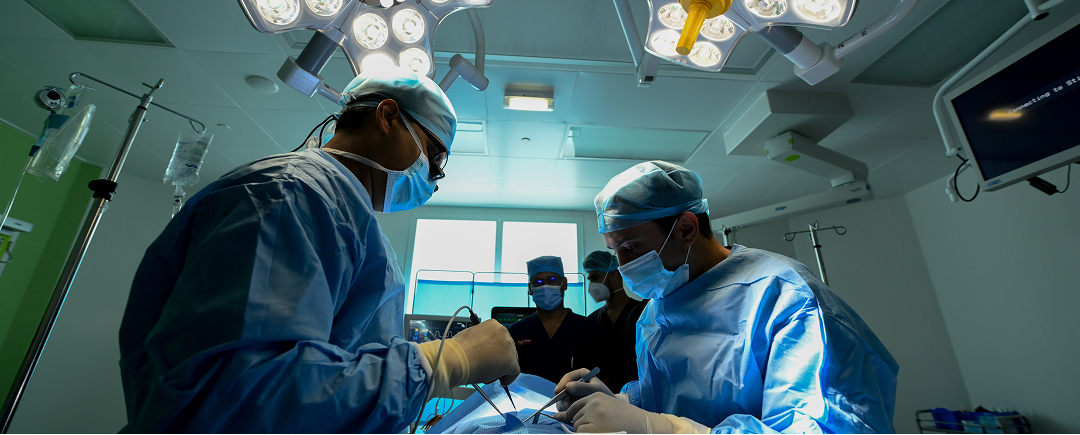
Pediatric Surgery
Advanced Pediatric & Neonatal Surgery— Minimally Invasive and Open Expertise.
From lifesaving neonatal procedures to complex adolescent reconstructions, delivered by fellowship-trained surgeons.
We provide comprehensive surgical management across all pediatric age groups, including neonatal emergencies, gastrointestinal and hepatobiliary surgery, thoracic and airway procedures, oncologic resections, urologic reconstruction, and trauma care. Weekly Surgical Board conferences integrate radiology, oncology, pathology, PICU, and rehabilitation to craft individualized, evidence-based plans. Enhanced Recovery After Surgery (ERAS) protocols and child-life support tools shorten hospital stays and improve outcomes.
6
board-certified pediatric surgeons1,150
surgeries in 2024—65% minimally invasive98%
survival for neonatal surgery cohort (global benchmark ≥96%)90%
same-day discharge for laparoscopic appendectomy & cholecystectomyCommon Conditions & Subspecialty Clinics.
- Anorectal malformation (ARM) repair
- Pull-through procedures for Hirschsprung disease
- Comprehensive bowel-management program
- Neuroblastoma
- Wilms tumor
- Sacrococcygeal teratoma (managed via multidisciplinary pediatric tumor board)
- Biopsy for lymphomas and suspected masses
- Congenital pulmonary airway malformation (CPAM)
- Bronchogenic cysts
- Mediastinal masses
- Lobar emphysema
- Tracheal and airway reconstruction
- Goals-of-care and code-status discussions
- Hypospadias repair with excellent outcomes
- Orchidopexy for undescended testis (open and laparoscopic)
- Chronic symptom control during survivorship
- Blunt and penetrating abdominal trauma
- Solid-organ injuries (liver, spleen, kidney)
- Chest trauma and rib fractures
- Pediatric gynecological trauma
- Laparoscopic appendectomy
- Pyloromyotomy for pyloric stenosis
- Hirschsprung disease pull-through
- Nissen fundoplication
- Choledochal cyst excision
- Pediatric ovarian masses
- Congenital Anorectal malformation reconstruction
- Intestinal atresia
- Necrotizing enterocolitis (NEC)
- Congenital diaphragmatic hernia
- Large Congenital Pulmonary Adenomatoid Malformations
- Abdominal wall defects (e.g., gastroschisis, omphalocele)
- Neonatal Urology: Bladder extrophy, cystoscopy, posterior urethral valve fulguration, disorders of sexual development (DSD), hydronephrosis
Procedures & Treatments.
Single-Incision Laparoscopic Surgery (SILS) for appendectomy & cholecystectomy
Robotic Surgery (da Vinci Xi/SP)
Pyeloplasty, fundoplication, splenectomy, choledochal cyst
Laparoscopic & Thoracoscopic Surgery
Appendectomy, CDH repair, VATS bleb resection
Thoracotomy for esophageal atresia with TEF repair
Posterior sagittal anorectoplasty (PSARP) for ARM
Intestinal atresia repair, Kasai portoenterostomy, tumor resections
REBOA placement in hybrid trauma bay
Damage-control laparotomy, splenic salvage, thoracotomy
Virtual-reality distraction therapy during dressing changes
Early feeding and mobilization protocols
Multimodal analgesia, regional blocks, opioid-sparing pathways
Care Pathway & Coordination.
Referral & Pre-op Assessment
Imaging, labs, anesthesia consult within 48 hours (urgent cases immediate).
Multidisciplinary Surgical Board
Plan finalized with PICU, anesthesia, radiology.
Definitive Procedure
Minimally invasive, robotic, or open surgery in hybrid OR.
Immediate Post-Op
PACU or PICU stabilization; pain & fluid management.
Family-Centered Rounds & Education
Daily updates, discharge goals shared.
Follow-Up & Rehabilitation
Clinic visit at 1–2 weeks; physiotherapy and scar-management sessions as needed.
Technology & Facilities.
Hybrid Pediatric OR
Fluoro & cone-beam CT for intra-op imaging
da Vinci Xi & SP Robotic Platforms
Pediatric instruments, 3-mm ports
Low-Dose Portable CT & Intra-op Ultrasound
Digital OR Integration
Live video streaming & documentation
Child-Life & Family Waiting Suites
Real-time surgical updates




